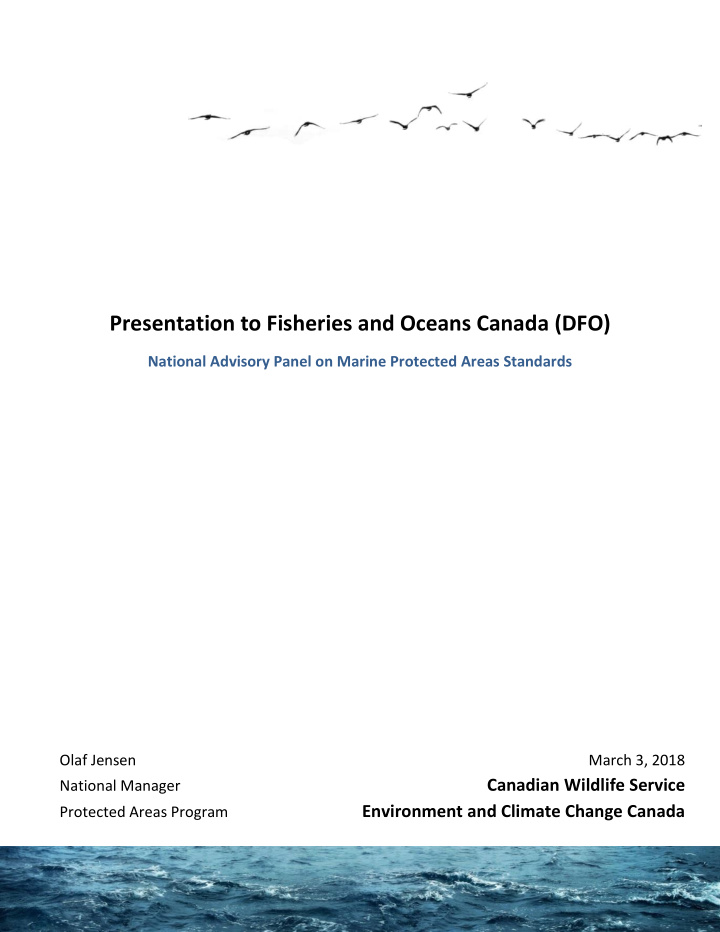



Presentation to Fisheries and Oceans Canada (DFO) National Advisory Panel on Marine Protected Areas Standards Olaf Jensen March 3, 2018 Canadian Wildlife Service National Manager Protected Areas Program Environment and Climate Change Canada
Table of Contents Mandate of ECCC and the Canadian Wildlife Service: ........................................................................ 3 History and Status of ECCC Marine Protected Areas: ......................................................................... 3 Historical role and evolution of the ECCC Protected Areas Program ................................................ 3 Evolution and purpose of Migratory Bird Sanctuaries .......................................................................... 4 Migratory Bird Sanctuaries ....................................................................................................................... 4 Marine National Wildlife Areas Legislative Framework ........................................................................ 5 National Wildlife Area Selection Criteria ................................................................................................. 5 Establishment Process .............................................................................................................................. 6 Regulations, Prohibitions, and Instruments ............................................................................................ 6 Vision and Guiding Principles ................................................................................................................... 7 Indigenous Co-Management and Reconciliation .................................................................................. 8 Budget 2018 ................................................................................................................................................ 9 Scott Islands as a protected area .......................................................................................................... 11 Concluding remarks ................................................................................................................................. 12 2
Mandate of ECCC and the Canadian Wildlife Service: Protected areas are established in Key Biodiversity Areas for the recovery of species at risk and the conservation of migratory birds and other wildlife . Further, our vision is that National Wildlife Areas and Migratory Bird Sanctuaries conserve key areas of biodiversity for the benefit of wildlife and the long term benefit of all Canadians and encourage public understanding and participation in the conservation of wildlife and habitat. History and Status of ECCC Marine Protected Areas: From 1887 until present day 54 National Wildlife Areas and 92 Migratory Bird Sanctuaries have been established. EC’s Protected Areas cover 12.4 million hectares (an area twice the size of Nova Scotia) and comprise 1.1% of Canada’s terrestrial area and inlan d waters. i. 54 National Wildlife Areas (988 111 hectares) ii. 92 Migratory Bird Sanctuaries (11 465 975 hectares) iii. Totalling over 12.4 million hectares (marine & terrestrial portion) The marine portion of existing National Wildlife Areas and Migratory Bird Sanctuaries covers 19,616km2 of Canada’s marine and coastal environment (0.34% of Canada’s coastal and marine area). The proposed Scott Islands marine National Wildlife Area would protect a further 11,514km2 (0.20%). Historical role and evolution of the ECCC Protected Areas Program The Canada Wildlife Act (1973) and the Migratory Bird Convention Act (1917) were the first acts in Canada to specifically enable the creation of protected areas whose primary purpose was wildlife and habitat conservation. National Wildlife Areas and Migratory Bird Sanctuaries fill an important niche by prioritizing the protection of habitat for species at risk and migratory birds. Many provincial, territorial and federal protected areas are established for purposes of recreation, tourism, watershed protection, or to protect areas representative of Canada’s natural beauty. These areas have ancillary benefits for biodiversity conservation. ECCC’s Protected Ar eas primary purpose is biodiversity conservation. This role is unique. The Canada Wildlife Act was the first Act in Canada to specifically enable the creation of protected areas whose primary purpose was wildlife and habitat conservation. The federal leadership role was clear: the need for habitat protection for wildlife conservation had been acknowledged and the federal government took the lead in creating an Act that would enable the creation of a network of protected areas. However, since the promulgation of the Canada Wildlife Act in 1973 every jurisdiction in Canada (the federal government, provinces and territories) has legislative tools that enable the creation of protected areas. These are diverse and include national parks, provincial parks, wildlife areas, conservation 3
areas, heritage rangelands, private nature reserves, Indigenous protected areas, sanctuaries, and marine parks to name but a few. At present count, there are 53 separate Acts that are used, or could be used to establish 77 difference types of protected areas. The diverse range of protected areas in Canada are nearly completely captured by and categorized within the IUCN Protected Areas Management Categories according to their management objectives. Evolution and purpose of Migratory Bird Sanctuaries Migratory Bird Sanctuaries were established at a time when the most important threat to conservation was overhunting. Many of the early Migratory Bird Sanctuaries in Canada were established to protect birds, nests, and eggs from direct threats: hunting for meat, for the feather trade, and egg harvest for food and for oölogy. i. Last Mountain Lake 1887 “wild fowl” ii. Betchouane MBS 1925 Eider ducks iii. Corossol Island MBS 1937 Eider ducks For almost 50 years, Migratory Bird Sanctuaries were the only regulatory tool available federally to protect wildlife and habitat. When important habitat for migratory birds was recognized as such by government scientists in Nunavut, for example, it was protected under the Migratory Bird Convention Act , including: i. Queen Maud Gulf MBS 1961 62,928 km2 ii. Bylot Island MBS 1925 12,827 km2 iii. Banks Island MBS 1961 20,199 km2 A national habitat program was implemented by the Government of Canada, through the Canadian Wildlife Service, in 1966. This program responded to widespread national concern regarding the loss of important wildlife habitat throughout Canada. Originally restricted to wetlands important for migratory birds, the system now includes areas that are important and unique for other wildlife species. For example: i. CFB Suffield NWA 2003 458 km2 ii. Portobello Creek NWA 1995 22 km2 iii. Akpait NWA 2010 791 km2 iv. Ninginganiq 2010 3,364 km2 v. Polar Bear Pass 1985 2,636 km2 Migratory Bird Sanctuaries Where MBSs are located on federal land, Environment and Climate Change Canada is responsible for the management and protection of migratory birds, nests, eggs and habitat. Where MBSs are located on provincial land, Environment and Climate Change Canada is responsible for the protection of migratory birds and their nests, while the chief game officer of the province is responsible for the management of habitat. Where MBSs are located on private or municipal land, Environment and Climate Change Canada is 4
Recommend
More recommend